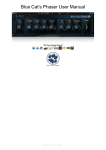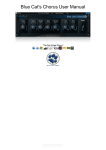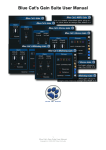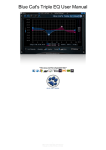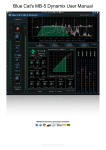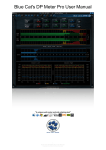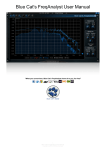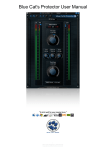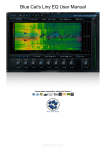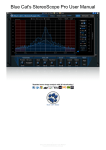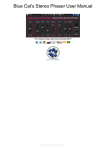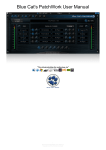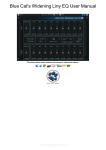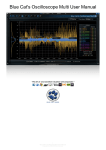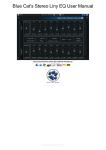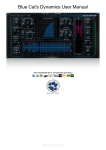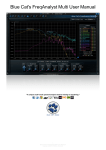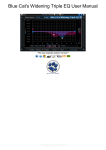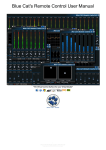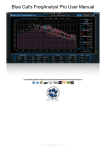Download Blue Cat`s Gain Suite User Manual
Transcript
Blue Cat's Gain Suite User Manual
1
Blue Cat's Gain Suite User Manual
Copyright (c) 2006-2014 Blue Cat Audio
Table Of Content
Introduction
Description
Features
System Requirements
Installation
Using Blue Cat's Gain Suite
The User Interface
Blue Cat Audio Plugins Basics
User Interface Basics
Controls
Keyboard
Mouse
Presets Management
MIDI & Automation Control
More
Blue Cat's Gain Suite Parameters
Plug- in Settings
The Global Settings Window
The Preset Settings Window
About Skins
Changing the Skin
Create a Custom Skin
Frequently Asked Questions
More
Extra Skins
Tutorials
Updates
Versions History
Note: An online version of this user manual is available here.
2
Blue Cat's Gain Suite User Manual
Copyright (c) 2006-2014 Blue Cat Audio
Note: An online version of this user manual is available here.
Introduction
Description
This plug- in suite is a series of gain utilities which let you control the volume of one or several audio tracks in real time. The interest
of these plug- ins resides in their particular features:
First, they include advanced automation MIDI control capabilities (all response curves can be fully customized). Used together with
one of our analysis tools or a MIDI controller, these plug- ins let you remotely control and automate the gain of each channel of the
audio signal, wherever they reside in the signal path.
Another interesting and exclusive feature is the ability to link several instances of the same plug- in: thanks to our unique data
sharing technology, you can control the gain of several tracks at the same time with a single slider.
The package provides a single channel (mono or stereo) as well as a dual channel version with mid/ side capabilities for
independent control of the left and right or mid and side channels. It can be very useful for stereo widening/ narrowing your stereo
tracks.
Note: Additional information about stereo widening with mid/ side processing can be found in our M/ S processing paper.
Features
Main Features
Blue Cat Audio Standards:
Single or dual channels gain plug- ins.
Stereo or mid- side processing.
Multiple instances linking capability: link several instances of the
same plugin and control several plugins from a single user
Available as: Mac- AAX, Mac- AU, Mac- RTAS, Mac- VST, WinAAX, Win- DX, Win- RTAS, Win- VST, Win x64- AAX, Win x64DX, Win x64- VST.
Native DSP code for optimal performance.
interface.
Relative, absolute or reverse link.
Full MIDI control and automation support with silent, zipper- free
parameters update, advanced response control and MIDI Learn.
No CPU load on idle: when the plug- in is fed with silence, the
processing smoothly shuts down, to optimize the CPU usage of
your Digital Audio Workstation.
Skinnable and customizable user interface with transparency
management.
Smooth Bypass: activate/ deactivate the plug- in with absolutely
no noise.
Undo/ Redo.
Full featured integrated presets manager.
Copy/ paste the plug- in's state between instances using the
system clipboard.
Any sample rate supported.
System Requirements
Windows
Mac OS X
An SSE2- enabled processor (Pentium 4 or later).
Microsoft Windows XP, Vista, Windows 7 or 8.
Any DirectX / VST / RTAS / AAX compatible host software (32 or
An Intel processor.
Mac OS X Mavericks(10.9), Moutain Lion (10.8), Lion (10.7),
Snow Leopard (10.6), or Leopard (10.5).
64 bit).
Any VST / Audio Unit (32/64- bit) / RTAS / AAX compatible
application.
For more information about supported platforms, see our FAQ.
Installation
Blue Cat Audio plug- ins cannot be run standalone, they require a host application (see the System Requirements chapter for more
information). Depending on which host application you use, you might need to install the plug- ins in different locations.
Windows
Install
3
Blue Cat's Gain Suite User Manual
Copyright (c) 2006-2014 Blue Cat Audio
All versions of the plug- in provide an installation program. Follow the steps of the wizard to install the plug- in on your machine.
During the installation you will be asked where you want the plug- in(s) to be installed. For the VST version you should install the
plug- in inside the VST plug- ins folder used by your host application(s). The default path set in the installer should work for most
applications, but you should check your host software documentation to know where it looks for VST plug- ins.
Some applications will not automatically rescan the new plug- ins, so you might have to force a refresh of the plug- ins list.
Upgrade
When a new version of the plug- in is released, just launch the new installer: it will update the current installation.
Uninstall
To uninstall the plug- in, simply launch the "Uninstall" program that is available in the start menu or in the configuration panel. It will
take care of removing all files from your computer.
Mac
Install
On Mac the plug- ins are available as drive images. After download, double click on the file to open it. You can then drag and drop
the plug- in file(s) to the shortcut that is provided within the image. It will install the plug- in(s) for all users on the machine.
In case you do not have admin rights on your Mac or if you want to install the plug- in(s) to another directory, just copy the files to
the appropriate location. If required, more information is available in the README.txt file that is included in the package.
Upgrade
When a new version of the plug- in is released, open the new image and copy the files over the previous ones. The new version will
replace the older one.
Uninstall
To uninstall the plug- in, simply remove the plug- in components from the folder where you have copied them during install (move
them to the trash).
If you want to completely remove all settings and configuration files, you can also remove these additional directories that may
have been created on your computer:
~/ Library/ Preferences/ Blue Cat Audio/ [Plug- in name and TYPE], where TYPE is VST, AU, RTAS or AAX: global
preferences.
~/ Documents/ Blue Cat Audio/ [Plug- in name]: user data, such as presets, additional skins and user- created plug- in data.
Just beware that these directories may contain user data that you have created. Remove these directories only if you wo not want
to reuse this data later.
4
Blue Cat's Gain Suite User Manual
Copyright (c) 2006-2014 Blue Cat Audio
to reuse this data later.
Using Blue Cat's Gain Suite
The User Interface
Note: The main toolbar, menus and basic features available with all our plug- ins are detailed in the Blue Cat Audio Plug- ins
Basics section.
Overview
The included skins offer a special linking capability which lets you link several instances of the same plug- in on up to nine
channels. Only several instances of the same plugins can be linked together. You won't be able to link the mono and stereo
versions for example.
To link the current instance with a particular channel, just select the channel (from A to I) you want to be linked to. The “X” button
can be used to unlink the plugin so that it works in standalone mode.
There are several options for the link with other instances on a given channel:
Absolute/ Relative: in absolute mode the values of the controls for the current instance and the selected channel are kept
identical, whereas in relative mode only controls variations are reported on the linked channel (letting you setup a different
gains on each instance, and then apply linked modifications for example).
Normal/ Reverse:in reverse mode, the gain value for both the current instance and the linked channel are reversed. It is very
handy when you want to use the plugin as a balance between tracks.
Using the "Show Link" button in the title bar or by clicking on the link summary at the bottom of the plug- in, you can toggle the
visibility of the link options. Below is a screenshot of the dual channels plug- in after hiding the link properties pane:
5
Blue Cat's Gain Suite User Manual
Copyright (c) 2006-2014 Blue Cat Audio
The various elements of the user interface (knobs, sliders, buttons...) are simple and intuitive to operate, but more information
about how to interact with them is available in the "Plug- ins Basics" chapter of this manual.
6
Blue Cat's Gain Suite User Manual
Copyright (c) 2006-2014 Blue Cat Audio
Blue Cat Audio Plug- ins Basics
This chapter describes the basic features that are common to all our plug- ins. If you are already familiar with our products, you can
skip this part.
User Interface Basics
About Skins
Like all Blue Cat Audio plug- ins, Blue Cat's Gain Suite uses a skinnable user interface. It means that the appearance and behavior
of the user interface can be entirely customized.
Especially with third party skins, the experience may be quite different from the one offered by the default skins that we provide.
However, our plug- ins and our skinning engine have several standard features that will be available whatever your favorite skin.
More information about custom skins can be found in the skins section.
The Main Toolbar
In most skins, an optional toolbar at the top of the user interface gives you access to the main options and settings of the plug- in:
Presets Area
At the center of the toolbar, you can see the current preset area (the "Default Settings" box). It displays the name of the current
preset, with a "*" at the end if it has been modified since loaded.
The arrows on the left and right let you navigate thru the (factory and user) presets available for the plug- in.
Clicking on the preset name opens the presets menu which lets you manage the presets of the plug- in.
Commands
The icons in the toolbar give you access the to the following commands that are detailed in the next paragraph:
Icon
Name
Function
Menu
Open the main menu
Undo
Undo
Redo
Redo
Manual
User Manual
About
About
The Main Menu
The main menu is available from the main toolbar, or if you right click anywhere on the background of the plug- in:
Presets: opens the presets menu to manage presets.
Set Preset Skin: change the skin for the current preset.
7
Blue Cat's Gain Suite User Manual
Copyright (c) 2006-2014 Blue Cat Audio
Set Preset Skin: change the skin for the current preset.
Use Global Skin: use the skin defined in the global settings for the current preset. This item is enabled only if a skin has
been defined for the current preset.
Undo/ Redo: undo or redo the latest modifications. This includes all changes made to the current preset settings such as
MIDI or automation preferences.
Presets Settings: open the presets settings window. It lets you change the skin, MIDI and automation settings for the
current preset.
Global Settings: open the global settingswindow. It lets you change the skin, MIDI and automation settings that are used by
default in all instances of the plug- in (if not overriden by the current preset).
User Manual: open this user manual.
Check for Updates: opens up our website to let you check if any update for this software is available.
Get More Skins: get more skins for this software.
Legal Information: browse licensing and misc legal documents.
About: displays the “about” dialog box.
The Title Bar
In most skins, an icon bar is located below the main toolbar. The first commands are the same for all plug- ins:
From left to right:
Smooth Bypass: smoothly bypass the plug- in (just like a power button).
Window Opacity: reduce the opacity value by turning the knob, and make the the plug- in window transparent. (the result
may depend on the host application).
Show/ Hide MIDI and Automation Control Settings: show/ hide the buttons that give access to direct MIDI/ Automation
setup for each parameter in the user interface. This button will show or hide dropdown menu buttons that popup a MIDI/
Automation setup menu described here.
Controls
Examples
Here are a few examples of typical controls you will encounter in the user interface of our plug- ins:
slider
slider
knob
button
Text control
Interacting with Controls
You can interact with the controls of the plug- in interface either with the mouse or the keyboard.
Setting the keyboard focus on a control (so that it responds to key strokes) may be automatic (when you pass the mouse over it it
gets focus) or manual (you have to click on the control to set the focus on it). Note that all host applications behave differently
regarding keyboard handling. In some applications you may not be able to use all keys described later in this manual to interact
with our plug- ins. It is usually made obvious to you to know the active surfaces of the skin (the places where you can click with the
mouse): the mouse cursor usually changes when you can do something on a control. In the default skins delivered with the plug- in,
the cursor changes to a small hand or an arrow to tell you when your mouse is over an active control.
Mouse
Various mouse movements will let you interact with the controls:
8
Blue Cat's Gain Suite User Manual
Copyright (c) 2006-2014 Blue Cat Audio
Mouse Interaction
Action
Left Click
Acquire focus and start dragging or push (button)
Left Click + Alt Key
Set the value to default
Acquire focus and launch the “fine tuning” edit box (except button):
Left Double Click
Right Click
Set the value to default
Mouse Wheel
Increment or decrement the position (focus required)
Mouse Drag
Change the control position depending on mouse movement (except button)
Keyboard
All control widgets support the following keys (note that some of them are caught by the host and thus never forwarded to the
control. For example in Steinberg Cubase SX you cannot use the arrow keys to control the plug- in):
Keys Common to All Controls
Key
Action
Up Arrow
Small increment of the position (up or right)
Down Arrow
Small increment of the position (down or left)
Left Arrow
Same as Down Arrow
Right Arrow
Same as Up Arrow
Page Up
Large increment of the position (up or right)
Page Down
Large decrement of the position (down or left)
+
Small increment of the value of the control
-
Small decrement of the value of the control
d
Set to default value (same as mouse right click)
Opens the 'fine tuning' window to precisely set the parameter:
e
SHIFT
When the key is down, the fine tuning mode is on, and you can modify the value with
better precision when moving the mouse, the mouse wheel or using the keyboard.
Just release the key to get back to the normal mode.
Keys Specific to Buttons
Key
Action
Enter
Pushes the button
Presets
To get started with the plug- in and discover its capabilities, a couple of factory presets are provided. You can also save your own
presets and recall them later for other projects. Our plug- ins propose a full- featured preset manager to let you save, browse,
organize and recall its presets.
The Presets Menu
The presets menu can be opened from the main menu or the main toolbar. It displays the list of presets available for the plug- in as
well as commands to load, save or organize presets:
9
Blue Cat's Gain Suite User Manual
Copyright (c) 2006-2014 Blue Cat Audio
Factory Presets: shows the list of factory presets delivered with the plug- in.
"Folder A" to "User Preset Z": user presets and categories.
Load: load preset from file.
Save As: save current preset to a file.
Copy copy preset to the system clipboard.
Paste paste preset from the system clipboard, if available.
Save As Default: save the current state as the default preset. This preset is used every time a new instance of the plug- in is
created.
Reset Default: reset the default preset to its factory state: this makes the plug- in forgets the custom settings you might have
saved as a default preset.
More about Presets
There are two types of presets: factory presets (read only) that are provided with the plug- in, and user presets that can be created
and stored by the user.
The user presets are stored in a subdirectory of the documents folders of your profile ("Documents" on Mac, and "My Documents"
on Windows): Blue Cat Audio/ [Plug- in Name]/ Presets. Each preset is stored as an individual file. You can create folders and
subfolders in the Presets directory to classify your presets, as shown in the example below:
If you save a preset named "Default" in the root Presets directory, it will override the factory default preset (that's what "Save As
Default" does). To restore the factory default preset, you can just remove this file or use the "Reset Default" command.
MIDI and Automation Control
Blue Cat's Gain Suite can also be remotely controlled via MIDI using MIDI CC ("Control Change") messages or automation curves,
if your host application supports it. It is possible to customize the channel, control numbers, range and response curve used for
each parameter in the settings panel available from the main menu (see the Plug- in Settings chapter for more details).
MIDI and Automation Settings Menu
Most skins also provide the ability to change MIDI and automation settings for each parameter directly in the main user interface.
When this feature is activated using the corresponding title bar button, dropdown menu buttons appears next to main controls:
Clicking on this button shows the MIDI/ Automation settings menu:
10
Blue Cat's Gain Suite User Manual
Copyright (c) 2006-2014 Blue Cat Audio
MIDI Learn: launches MIDI learn mode for the control: touch your MIDI controller and the control will learn from it the MIDI
channel and CC number. To end the learn mode, reopen this menu and deselect the option.
MIDI Unlearn: deactivates MIDI control for this parameter.
Settings: launches the advanced settings panel described below. This controls the settings for the current preset.
Andvanced MIDI and Automation Settings
You can completely customize the way the plug- in is controlled by automation and MIDI. For a global view of all parameters at a
time, you can use the Plug- in Settings window for the current preset which is available from the main menu.
MIDI Settings:
Enable MIDI: enable/ disable the MIDI control of the parameter.
Channel: MIDI Channel for the parameter control. If set to 0, the plug- ins will accept Control Change Messages from all
MIDI Channels (MIDI Omni mode).
CC: Control Change Number.
Learn: click on this button to activate the MIDI learn functionality. When it is activated, you can move your MIDI controller,
and the plug- in will automatically set the MIDI Channel and CC Number.
MIDI and automation settings:
Response: response curve of the MIDI or automation control: from very fast to slow control.
Min: minimal value of the parameter when MIDI controlled or automated.
Max: Maximum value of the parameter when MIDI controlled or automated.
Note: if the Min value is higher than the Max value, the response curve will be reversed: increasing the control value will decrease
the parameter value.
Note: if you double click on the parameter text control boxes for the max and min values, a “fine tuning” edit box will appear and let
you change the min and max values with more precision:
More
Check our online tutorial for more screenshots and more examples of our plug- ins user interfaces.
11
Blue Cat's Gain Suite User Manual
Copyright (c) 2006-2014 Blue Cat Audio
Blue Cat's Gain Suite Parameters
All parameters described below can be automated and controlled via MIDI if your host application supports it. You can precisely
define this behavior in the settings panels described later in this manual.
Input
<
The parameters of the plug- in are the following:
Param id
Name
Unit
Description
dsp.input0
Bypass
model.gain
Gain
model.groupA.enabled
Link Group A
Link the plugin to group A.
model.groupB.enabled
Link Group B
Link the plugin to group B.
model.groupC.enabled
Link Group C
Link the plugin to group C.
model.groupD.enabled
Link Group D
Link the plugin to group D.
model.link_relative
Relative
Set the link of the plugin in “relative” or “absolute”
mode.
model.link_reverse
Reverse
Reverse the plugin link.
Bypass the effect.
dB
Gain.
The parameters of the stereo version of the plug- in ('Stereo Gain') are the following:
Param id
Name
Unit
Description
dsp.input0
Bypass
model.gain1
Gain (L)
dB
Gain for the left channel.
model.gain2
Gain (R)
dB
Gain for the right channel.
model.groupA.enabled
Link Group A
Link the plugin to group A.
model.groupB.enabled
Link Group B
Link the plugin to group B.
model.groupC.enabled
Link Group C
Link the plugin to group C.
model.groupD.enabled
Link Group D
Link the plugin to group D.
model.link_relative
Relative
Set the link of the plugin in “relative” or “absolute”
mode.
model.link_reverse
Reverse
Reverse the plugin link.
Bypass the effect.
12
Blue Cat's Gain Suite User Manual
Copyright (c) 2006-2014 Blue Cat Audio
The parameters of the mid / side version of the plug- in ('Widening Gain') are the following:
Param id
Name
Unit
Description
dsp.input0
Bypass
model.center
Center
%
Position of the 'virtual center' (position of the mid
channel) in the stereo field. -100% is left and 100% is
right.
model.gain1
Gain (M)
dB
Gain for the mid channel.
model.gain2
Gain (S)
dB
Gain for the side channel. Increase the value to
increase the stereo perception of the track.
model.groupA.enabled
Link Group A
Link the plugin to group A.
model.groupB.enabled
Link Group B
Link the plugin to group B.
model.groupC.enabled
Link Group C
Link the plugin to group C.
model.groupD.enabled
Link Group D
Link the plugin to group D.
model.link_relative
Relative
Set the link of the plugin in “relative” or “absolute”
mode.
model.link_reverse
Reverse
Reverse the plugin link.
Bypass the effect.
13
Blue Cat's Gain Suite User Manual
Copyright (c) 2006-2014 Blue Cat Audio
Plug- in Settings
In addition to the controls offered in the main user interface, Blue Cat's Gain Suite has various settings that let you fine tune the
behavior of the plug- in. You can choose to change these settings either for the current preset or globally for all instances of the
plug- in.
The Global Settings Window
The settings available in this window apply to all instances of the plug- in, for all presets, if not overriden in the presets settings.
Consider these settings as “default” settings.
General
You can change the default skin for all instances of the plug- in: write the skin file path in the text edit box or click on the button to
open a file chooser dialog. If you have several instances of the plug- in opened in your session, you will have to re- open the user
interfaces of these plug- ins to see the skin change.
The output data refresh rate can also be customized for all instances of the plug- in. It controls the refresh rate of non- audio data
produced by the plug- in (parameters, curves...). It also controls the refresh rate of output MIDI CC messages or output automation
data. The higher the refresh rate, the better precision, but also the higher cpu usage (some host applications may also have trouble
recording MIDI data at high refresh rates). The default value is 50 Hz.
Global Control Input Settings (MIDI and Automation)
The plug- in offers a couple of settings that affect the way it is controlled by MIDI messages or automation. While the first settings
only apply to MIDI control, the "Control Response", "Min" and "Max" settings apply to both automation and MIDI control.
For each parameter you can define a default MIDI channel and CC number. You can then control the plug- in with an external MIDI
controller or one of our plug- ins that generate MIDI messages.
The settings below are available for each plug- in parameter.
MIDI Settings:
Enable MIDI: enable/ disable the MIDI control of the parameter.
Channel: MIDI Channel for the parameter control. If set to 0, the plug- ins will accept Control Change Messages from all
MIDI Channels (MIDI Omni mode).
CC: Control Change Number.
14
Blue Cat's Gain Suite User Manual
Copyright (c) 2006-2014 Blue Cat Audio
CC: Control Change Number.
Learn: click on this button to activate the MIDI learn functionality. When it is activated, you can move your MIDI controller,
and the plug- in will automatically set the MIDI Channel and CC Number.
MIDI and automation settings:
Response: response curve of the MIDI or automation control: from very fast to slow control.
Min: minimal value of the parameter when MIDI controlled or automated.
Max: Maximum value of the parameter when MIDI controlled or automated.
(generic screen shot, does not correspond to the actual plug- in parameters)
Note: if the Min value is higher than the Max value, the response curve will be reversed: increasing the control value will decrease
the parameter value.
Note: if you double click on the parameter text control boxes for the max and min values, a “fine tuning” edit box will appear and let
you change the min and max values with more precision:
The Current Preset Settings Window
In this window you can change the settings for the current preset of the current instance of the plug- in only.
Preset Skin
You can choose to use the global skin setting or to change the skin for the current preset. This way you can have different skins for
different instances of the plug- in in the same session in order to differentiate them.
15
Blue Cat's Gain Suite User Manual
Copyright (c) 2006-2014 Blue Cat Audio
Preset Control Input Settings (MIDI and Automation)
Use the global settings or override them for the current preset. The parameters are the same as for the global input settings.
(generic screen shot, does not correspond to the actual plug- in parameters)
16
Blue Cat's Gain Suite User Manual
Copyright (c) 2006-2014 Blue Cat Audio
(generic screen shot, does not correspond to the actual plug- in parameters)
About Skins
Blue Cat's Gain Suite integrates Blue Cat's skinning engine that allows you to customize the user interface. You can download new
skins for your plug- in at the following address:
http:// www.bluecataudio.com/ Skins/ Product_GainSuite
If you don't find a skin that fits your need or if you want a really custom one, you can choose to create your own skin.
Changing the Skin
You have two ways to change the skin of your plug- in: you can change the default (or 'global') skin in the global settings, or change
the skin for the current preset only (either in the preset settings page or from the main menu). The global skin applies to all plug- in
instances, whereas the current preset skin only applies to the current preset of the current plug- in instance.
See the main menu for more information about how to access these options.
On some hosts the plug- in window won't resize automatically when you choose a skin with a different size. In this case, just close
the window and re- open it: it will be displayed with the right size.
Create a Custom Skin
You can create custom skins for your plug- in in order to adapt it to your exact needs. You can change its look and feel and make it
completely integrated in your virtual studio!
Just read the Blue Cat's Skinning Language manual and download the samples for the tutorial on http:// www.bluecataudio.com/
Skins. You can get ready to create your own skins in a few minutes.
You can then share your skins on our website.
17
Blue Cat's Gain Suite User Manual
Copyright (c) 2006-2014 Blue Cat Audio
FAQ
Plug- ins Formats
What are DirectX (DX), Audio Unit (AU), RTAS, AAX and VST plug- ins?
VST, Audio Unit, RTAS, AAX and DirectX plug- ins are software components than can be used in "Host" Software (such as
Cakewalk Sonar, Steinberg Cubase or Wavelab, Sony Vegas, Logic Pro, Garage Band, Ableton Live, Pro Tools...) in order to
perform some MIDI and/ Or Audio real- time Processing tasks. To be more precise what we usually call directX plug- ins is actually
a "DirectShow Filter". VST is owned by Steinberg, DirectX by Microsoft while Audio Units is the property of Apple Computers and
RTAS and AAX are owned by AVID.
How can I use your plug- ins?
Download and install a host software, then download and install the plug- ins from our page. They will appear in the host "effects"
menu. If you are using a DirectX host with our MIDI controllable plug- ins and they do not show up in you host list, you might need
to use our freeware DXi Manager. Note that our plug- ins are sometimes shown in the "MIDI controllable audio effects" or "soft
synths" sections in some host applications.
Where can I find a host?
There are many commercial or freeware hosts that will suit your needs. You can find a long list of applications here. You can also
use demos of Cubase, Wavelab, Ableton Live, Tracktion, or Sonar software, which are usually available on the companies
websites. On the Mac, Garage Band is part of the system and can be also used to host our Audio Unit plug- ins.
What are the main differences between DX, VST, RTAS, AAX and Audio Units?
VST is a protocol that works on several platforms (Mainly Windows, MacOS, BeOS, and some Linux platforms use it as well)
whereas DirectX is Microsoft Windows only, and Audio Units are available only on the Mac. RTAS and AAX are available on Mac
and PC, but only for Pro Tools products (AVID). AAX plug- ins are compatible with Pro Tools 10 and higher, whereas RTAS
versions are compatible for Pro Tools 10 and lower versions.
What is the difference between DXi and DX effects?
DXi effects are MIDI controllable DirectX plug- ins. It's the same as DX effects plus MIDI control.
Which version (VST, Audio Unit, RTAS or DX) should I use in my host application?
Here is a list of host software and the version we recommend you to use. Many other applications are supported, check your
application user manual to choose the best version (AU stands for "Audio Unit" and DX for "DirectX"):
Host Application
Plug- in Version
Cakewalk Products (Sonar, Project5...)
DX
Sony Products (Vegas, ACID, Soundforge)
DX for old versions, VST for new
Steinberg Products (Cubase, Nuendo, Wavelab)
VST (Mac or PC)
Ableton Live
VST (Mac or PC)
Adobe Audition
any
EnergyXT
VST
Magix Samplitude
VST
Avid (Digidesign) Pro Tools
RTAS
Apple applications (Logic Pro, Logic Express, Garage Band...)
AU
Cockos Reaper
VST (Mac or PC)
...
In general, we recommend using VST over Audio Unit on Mac (when
18 both are supported), particularly for the plug- ins that can
Blue Cat's Gain Suite User Manual
Copyright (c) 2006-2014 Blue Cat Audio
In general, we recommend using VST over Audio Unit on Mac (when both are supported), particularly for the plug- ins that can
output automation or MIDI CC messages.
Where can I find more information about this topic?
www.steinberg.net
www.microsoft.com
www.kvraudio.com
www.apple.com
www.digidesign.com
Installation
I have installed my software and it is not listed as an application. Why? What can I do? How can I launch it?
Most software you can purchase on this website is plug- ins for host applications. It means you need another application to use it.
See the "Plug- ins Formats" section in this FAQ for more information.
I have installed my plug- in and it does not show up in my host application. What can I do?
First check that you application supports DirectX, Audio Unit or VST plug- ins.
If you are using the DirectX version, check that your host application supports DXi plug- ins (MIDI enabled DirectX plug- ins). If it
does not, it may remove it from the DirectX plug- ins list (some applications such as Sony Vegas 5 and Cool Edit Pro are known to
do this). In this case, use our DXi Manager free utility and disable the MIDI capabilities of the plug- in. You may need to reinstall the
software again before it shows up into your host application. For more information about this topic please read our DXi in Sony
Vegas tutorial (it is applicable to other applications than Sony Vegas).
If you are using the Direct X version and your host application supports DXi, check that the plug- in does not appear in the 'virtual
synth' or 'synthesizers' category. If you wish not to use the MIDI capabilities of the plug- in and use it as a regular Direct X plug- in,
you can download the freeware DXi Manager and disable the MIDI capabilities of the plug- in.
I have installed my plug- in on windows 64- bit, checked the items above, and it still does not show up in my host
application. What can I do?
You are probably running a 32- bit application. If that's the case, you need to install the 32- bit version of the plug- in: the choice for
32 or 64- bit is not determined by the operating system (64- bit windows can run both 32 and 64- bit applications), but by the host
application that you are using.
Why are there two plug- ins called xxxx(Mono) and xxxx(Stereo) installed ?
"Mono effects" (which are effects that do not make any difference between left and right channels) are bundled this way for
performance reasons. Some developers just deliver a stereo Version which also processes (twice) mono streams. The "(Mono)"
plug- in is to be used with mono streams, and the (Stereo) one with stereo streams. The effect itself is the same in both cases but
the number of processed channels is different: this may drastically improve performance for CPU intensive plug- ins.
How do I uninstall my plug- ins?
Open the Windows configuration panel/ Add Remove Programs, and choose 'Remove' on the corresponding plug- in. If you have
installed the VST plug- in zip file version, just delete the corresponding dlls.
Why do your plug- ins need an installer on Windows? Do they modify the registry or system settings? Why not providing
just a dll?
Our plug- ins require several additional files for default settings, skins and miscellaneous data. We provide an installer for our
customers' convenience. Our installers do not modify the system settings or the Windows registry, except for the DirectX versions
registration. Our installers won't harm your system.
Software Version
How do I know the version of the plug- in I am using?
You can see the version information in the about box: right click on the background of the plug- in user interface and select "About".
The product version is also available in the Windows Add/ Remove Programs Window.
Why do newer versions of a plug- in override older ones (they have exact same name and IDs)?
19
Blue Cat's Gain Suite User Manual
Copyright (c) 2006-2014 Blue Cat Audio
Because newer versions improve previous ones. When a new version is released, older versions are not supported anymore. In
some cases the new versions may be installed as new products (compatibility reasons, major changes...), but it is explicitly
documented on the product page.
A new minor version of a product I purchased some time ago is available. Where can I download the update?
The new version can be downloaded from the same place where you downloaded the original version. All information is contained
in the email you received when you purchased the product. Your registration number has not changed either.
Upgrade
A new minor version of my plug- in has been released. Where can I download it?
When you purchased the plug- in, an email containing the information to download and register your software has been sent to
you. You can download the new version from the exact same location as the first time.
I have downloaded a new version, do I need to uninstall the previous version?
No, you don't, except if it's specified on the product page, in the "history" section. Just run the installer and it will upgrade your
software.
Automation
What is "Parameters Automation"?
The parameters of an effect can be automated in most host software. It means that you can record the changes you do during
playback or recording so that it's replayed when playing back again. It's a way of sequencing parameters changes the same way
you do with Audio or MIDI data.
What is "Smooth Update"?
When changing parameter values in real time or replaying a song where parameters have been automated, our plug- ins compute
intermediate values between parameter changes in order to avoid "clicks" and "pops" that may occur otherwise. It results in a non
audible smooth parameters update and lets you freely use automation or MIDI control to change the effects in a song.
Do your plug- ins support MIDI Control?
Yes they do. They offer precise control over the mapping of MIDI Control Change (CC) messages to parameter values: you can
adjust both the channel and CC number as well as the response curve of the control. Since some of our plug- ins are also capable
of creating MIDI CC from the audio signal, they can all be connected for real time signal- dependent audio effects. See our MIDI
Control in Sonar tutorial for an example.
20
Blue Cat's Gain Suite User Manual
Copyright (c) 2006-2014 Blue Cat Audio
More...
This manual only covers the basics of Blue Cat's Gain Suite. Our website offers many additional resources for your Blue Cat's Gain
Suite plug- in and is constantly updated, so keep an eye on it! You will find below a few examples of available resources.
Extra Skins
We encourage our customers to propose their own skins for our products and we often propose alternative skins to let you choose
the one that best suits your needs. You can check Blue Cat's Gain Suite skins page to get the latest skins.
Long Faders
Product: Gain Suite
Description: Skin set replacement for the three plug- ins included in the pack, with long and
precise faders (up to .01 dB steps).
Author: Blue Cat Audio
Download: Skin_LongFaders.zip
Tutorials
Many Tutorials are available on our website. They cover a wide range of topics and host applications. You will find below a list of
tutorials that are related to the Blue Cat's Gain Suite plug- in. An updated list is also available online.
Tutorial - Connecting Plug- ins with Groups in Cakewalk Sonar
This tutorial shows how to reuse the envelopes generated by our plugins with output parameters in
Cakewalk Sonar using groups. Other techniques exist (using MIDI or Automation curves), but this
one ha...
[Read More...]
Tutorial - Real Time Ducking: the DPMP as a Voice Over Tool.
This tutorial shows how to perform real time ducking in your favorite host, using the DP Meter Pro
plugin (DPMP). The following example is a typical "Voice Over" situation where you want to add a
vo...
[Read More...]
Tutorial - Blue Cat's Digital Peak Meter Pro In Samplitude
21
Blue Cat's Gain Suite User Manual
Copyright (c) 2006-2014 Blue Cat Audio
This tutorial shows how to use the DP Meter Pro audio analysis plugin (DPMP) in MAGIX
Samplitude, in order to modify the parameters of an effect on a track according to the envelope of
an other track....
[Read More...]
Tutorial - Using DXi plug- ins in Sony Vegas
This tutorial will teach you how to use any DXi plug- in in Sony Vegas: Sony Vegas does not
support MIDI automation, so if your plug- in supports the MIDI Dxi protocol, it is removed from the
plug- ins l...
[Read More...]
Tutorial - Real Time Side Chain Dynamics Processing
This tutorial shows how to perform side chain compression, ducking or gating with the Dynamics
plugin and the Gain Suite free plugins. Side Chaining consists in using a track signal to control an
ef...
[Read More...]
Tutorial - Monitoring an effect chain with the 'Multi' Series
The 'Multi' analysis plugins series offer the ability to compare the measurements made by several
instances within an audio project. In this tutorial you will learn how to use this capability to mon...
[Read More...]
Tutorial - Export Plugin Presets to Share them with the Community
This tutorial shows you how to export your presets in order to share them with the community on
the Blue Cat Audio website. This tutorial uses Blue Cat's Stereo Triple EQ for the demonstration
bu...
[Read More...]
Tutorial - Getting Started with Plug- ins User Interface
Get used to the user interface features of Blue Cat Audio products! They have been designed for
an optimal workflow, so here are the tips and tricks to save time. All these functionalities are
explain...
[Read More...]
Tutorial - Using MIDI Control in Sonar
This tutorial will help you understand how to use parameters MIDI control in Cakewalk Sonar. It is
applicable to any DXi plug- in (MIDI enabled DirectX plug- in)....
[Read More...]
Tutorial - Mid Side Processing
22
Blue Cat's Gain Suite User Manual
Copyright (c) 2006-2014 Blue Cat Audio
Mid / Side processing explained. Download this tutorial as a pdf file ...
[Read More...]
Tutorial - Using MIDI Connectivity in a Modular Host (Plogue Bidule)
This tutorial shows you how to use the MIDI connectivity of our plugins in a modular host such as
Plogue Bidule. We are using the Mac version of Bidule in this tutorial. The scenario here is very
sim...
[Read More...]
Tutorial - Remote Monitoring and Control with Blue Cat's Remote Control
This tutorial shows how to use the Remote Control MIDI control surface and DP Meter Pro audio
analysis plugin (DPMP) to monitor and control several tracks in a same screen. Before you read
this tutori...
[Read More...]
Tutorial - Using Blue Cat Audio plugins connectivity in Reaper
This tutorial shows how to use our plugins MIDI connectivity within Reaper. We use Blue Cat's
Dynamics plugin as an example, but you can use any other audio plugin which provides output
parameters, su...
[Read More...]
Tutorial - How to Use the Free Presets Available on this Website
This tutorial shows you how to get and load free presets for your favorite Blue Cat Audio plugin.
This tutorial uses Blue Cat's Dynamics for the demonstration but is applicable to all our plugins...
[Read More...]
Tutorial - Using Grouping Capabilities of Blue Cat's Gain Suite Plugins
The Blue Cat's Gain Suite free volume control plugins offer the ability to link several instances of
the same plugin to control them with a single slider. This tutorial shows how to use this capabil...
[Read More...]
Tutorial - Simple Dynamic Stereo Enhancement
This tutorial shows how to use the Widening Meter Pro and the freeware Gain Suite plugins to
enhance the stereo perception of a track. It's a very simple example of how to connect the
measurements cap...
[Read More...]
23
Blue Cat's Gain Suite User Manual
Copyright (c) 2006-2014 Blue Cat Audio
Updates
As you can see in the history log below, we care about constantly updating our products in order to give you the latest technology
available. Please visit our website often to check if Blue Cat's Gain Suite has been updated, or subscribe to our Newsletter to be
informed of the latest news about our products.
You can also follow us on twitter and facebook for almost real time updates notification, and subscribe to our YouTube channel to
see the latest videos about our software.
Versions History
V3.1 (2014/01/09)
New Features:
Copy/ paste the plug- in's current state from the presets menu using the system clipboard.
Improvements:
Reduced the plug- in's memory usage.
Windows VST Installer now remembers where the plug- in was initially installed to simplify upgrades.
(Mac) plug- in version number is now available when using "Get Info" in the Finder.
(Mac) Improved display of Audio Unit parameters in most host applications.
Bug Fixes:
Fixed window frame not showing with Cubase 7.5 (32- bit) on Mac.
(Mac) About window does not show up first in the corner of the screen anymore.
(Win) Alt- Click on a control now resets the value to default in Pro Tools, as expected.
Fixed version number reported to host application for VST and Audio Unit versions.
V3.02 (2013/06/21)
New Features:
64- bit AAX support for Pro Tools 11.
Audio Suite support for offline processing in Pro Tools (AAX).
Improvements:
The windows installer now automatically detects the most appropriate VST install path.
Bug Fixes:
Fixed AAX version not showing up in Pro Tools 10.3.5 on Windows.
(RTAS) Fixed parameters control with EUCON control surfaces in Pro Tools.
Fixed user interface issues in Final Cut Pro X.
Fixed compare button issues in Pro Tools.
Mac- VST: Fixed window resize issues on Cubase and Nuendo (Mac).
Mac: Control MIDI settings dialog now brought back to front when already opened in the background.
V3.01 (2012/04/23)
Bug Fixes:
AAX/ RTAS on Mac: Fixed audio engine freeze or error issue with Pro Tools on some Mac configurations.
AAX on Mac: Fixed compare button that did not work well when using factory presets or any preset created on Windows.
Performance improvement when running under high CPU load for other platforms.
V3.0 (2012/03/28)
New Features:
New user interface.
New integrated presets manager:
Load/ save presets from the plug- in's user interface.
Organize presets with folders.
Customize the default preset.
Exchange presets easily.
Increased the number of groups (9 groups instead of 4).
Automation range and response curve can now be customized for each parameter.
Automation and MIDI settings (channel, MIDI learn etc.) are now accessible from the main user interface.
AAX plug- in format is now also supported on Windows.
Improvements:
Plug- in name has been shortened for a clearer display in mixer view for most host applications.
The plug- in now appears in the "Dynamics" category in Pro Tools.
Changed the default VST install path on Windows.
Improved default response curve for automation and MIDI control.
Added new presets.
Improved value display in fine edit window.
Improved user manual.
Optimizations and Performance Improvements:
Reduced VST plug- in loading time.
Improved parameters precision (now stored as 64- bit).
More compact presets format (uses less space and loads faster).
Smaller binaries on Mac (dropped PowerPC support).
Bug Fixes:
Fixed presets- related crashes in Cubase on Mac.
Fixed user interface display issues in Wavelab on Mac.
Note: this new version can be installed side by side with the previous version for backward compatibility reasons: installing this
new version won't break your previous projects.
24
Blue Cat's Gain Suite User Manual
Copyright (c) 2006-2014 Blue Cat Audio
V2.43 (2011/02/10)
Fixed keyboard focus stealing issue in Pro Tools and several other host applications.
64- bit Mac VST support.
V2.42 (2010/03/19)
This update only concerns the RTAS version of the plug- in:
RTAS plug- in bug fix: when using both the mono and stereo versions in the same session, the controls of the instances
were linked together.
V2.41 (2010/02/25)
Space bar does not trigger plug- in buttons anymore (avoids conflict with transport control in most applications).
Fixed a crash on Mac and 64- bit Windows that randomly occured when opening and closing the user interface multiple
times.
Win x64: fixed issue with some hosts not opening the plugins.
Win x64: fixed issue with settings window that was not displayed properly in some hosts.
Mac: fixed keyboard/ mouse focus issues in some hosts.
Mac: fixed multiple screens issue.
V2.4 (2010/01/30)
RTAS plugin format support for Pro Tools (Mac and Windows).
64- bit applications support for Windows DX and VST under Windows x64.
Mac AU 64- bit format support (compatible with 64- bit Logic 9.1 on Snow Leopard)
Mac: fixed user interface crashes in some hosts under Snow Leopard.
Fixed MIDI learn issues.
V2.3 (2009/11/20)
RTAS plugin format support (final beta stage - currently available with the Free Pack only)
Mac: fixed keyboard/ mouse focus issues in some hosts.
Mac: fixed user interface crashes in some hosts, when used with particular display settings.
Mac- AU: fixed user interface resizing issue when changing skin in some hosts (Logic).
Mac- AU: fixed settings lost issue when doing offline rendering in some applications.
V2.2 (2009/09/21)
New Windows Installer (much faster install, improved upgrades).
Bug Fix (PC): Cubase freezes when loading a preset using a different skin while the plugin window is open.
Blue Cat's Skinning Language 1.6.1 support.
V2.11 (2009/05/05)
Mac VST update: fixed incompatibility issues with Cubase 5 on Mac.
V2.1 (2009/04/30)
Mac only: fixed the range of the gain parameter for automation and MIDI (was +-40dB instead of +-60 dB)
V2.1 (2009/02/03)
Mac Audio Unit Support.
V2.1 (2008/11/21)
First Mac version.
Improved parameters display in host application and settings window.
V2.0 (2007/08/14)
Link several instances of the same plugin and control several plugins from a single user interface.
Smooth Bypass: activate/ deactivate the plugin with absolutely no noise.
Undo/ Redo.
Load/ Save presets in a host- independent format: you can now share presets between the directX and VST versions.
Streamlined user interface with new GUI design and Blue Cat's Skinnning language 1.3.3 support:
New toolbar to access main functionalities.
Integrated window opacity support (make the user interface of the plugin transparent).
New layout and new look and feel.
V1.1 (2006/11/29)
Now supports Blue Cat's Skinnning language 1.2.4.
CPU efficiency improvement: no processing occurs when input is silent.
Settings window now loads faster.
(Bug fix): in some plug- in adapters (such as FxPansion's VST to RTAS adapter) the GUI did not display properly when first
loaded.
(Bug fix): when reinstalling the software in another directory, the "skin not found" message was displayed.
V1.0 (2006/11/06)
First version.
25
Blue Cat's Gain Suite User Manual
Copyright (c) 2006-2014 Blue Cat Audio
Thanks again for choosing our solutions!
See you soon on www.bluecataudio.com!
26
Blue Cat's Gain Suite User Manual
Copyright (c) 2006-2014 Blue Cat Audio


























